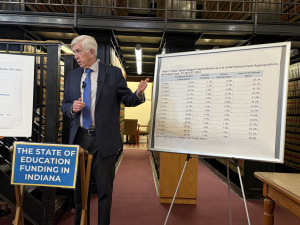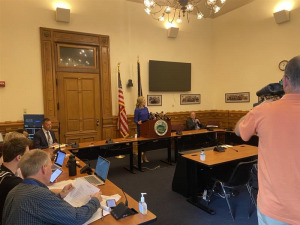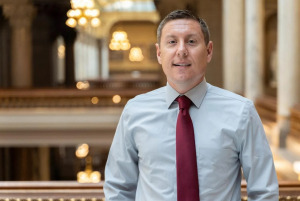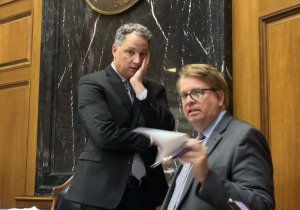
Fiscal issues expected to dominate 2025 Indiana legislative session
Lawmakers will convene Wednesday to begin drafting the state’s next two-year budget, determining how to spend approximately $44 billion dollars to fund government services.

Lawmakers will convene Wednesday to begin drafting the state’s next two-year budget, determining how to spend approximately $44 billion dollars to fund government services.

While education dominates half of Indiana’s budget and Medicaid costs worry lawmakers, a projected transportation infrastructure funding shortfall creeps closer.

A year the Holcomb administration revealed a shortfall in the state’s Medicaid program of nearly $1 billion, lawmakers will start working in January to piece together legislation that at least in part deals with the second-largest and fastest-growing item in the state budget.

An expected tight budget cycle could limit how much lawmakers are willing to designate for existing technical investments—never mind additional requests.

During the Indiana Chamber Legislative Preview event, Statehouse leaders said the biggest issue on the table—and a major campaign talking point—is property taxes.

Indiana’s public universities are seeking millions of dollars for capital projects, but the state’s Commission for Higher Education wants lawmakers to concentrate funding in the next budget cycle on deferred-maintenance projects.

Indiana’s State Budget Committee on Tuesday kicked off its first hearing for the upcoming 2026 and 2027 fiscal years. Lawmakers are set to file an initial vision for the $40 billion-plus biennial budget in January.

Democratic lawmaker Rep. Ed DeLaney of Indianapolis made public a new legislative analysis on Wednesday that showed the overall dollar amount spent on K-12 has grown each year, but its share of the state budget has dropped.

The Indiana Deferred Compensation Committee voted to eliminate public retirement assets from the funds as part of the state’s effort to divest from Chinese entities and funds prioritizing environmental, social and governance practices.

Closing the fiscal year this week, Indiana budget leaders say the state government’s finances are in a healthy spot despite posting its lowest reserves since the pandemic, an issue exacerbated by a $1 billion Medicaid shortfall discovered last December.

State Sen. Ryan Mishler, R-Bremen, and Rep. Greg Porter, D-Indianapolis, likened the city’s expected request to those more regularly made to the budget committee by the Indiana Economic Development Corp., which is not required to disclose much, if any, information about its dealings.

New data shows Indiana’s teacher pay is ticking up—but still trails averages in neighboring states—as the debate over Hoosier educator salaries continues.

The flawed forecast was based on data that did not reflect the latest needs of enrollees, state agencies said.

The state budget plan predicted revenue of about $1.6 billion but collections were short $139 million: almost 9% below expectations, according to a monthly revenue report.

The comments from Indiana State Budget Director Zac Jackson came during a virtual panel discussion on the impacts an economic recession would have on state budgets.

The Interim State and Local Tax Review Task Force, which began meeting Wednesday, will examine Indiana’s corporate tax, individual income tax, property tax, sales tax, and others.

Consumer spending that boosted state revenues has cooled after two years of above-average financial performance, bringing the state’s reserves back within a typical range.

A memo issued by the State Budget Agency last week says that, despite “our strong financial position,” the state needs “to be mindful of unknown factors.”

Under pressure from local schools and fellow Republican lawmakers, GOP leaders opted to decrease the amount dedicated to paying down the unfunded liability in pre-1996 Teacher Retirement Fund and shift an additional $312 million to K-12 schools.

Republican legislative leaders agreed Thursday to give about $300 million in additional funding toward Indiana schools in the new state budget.